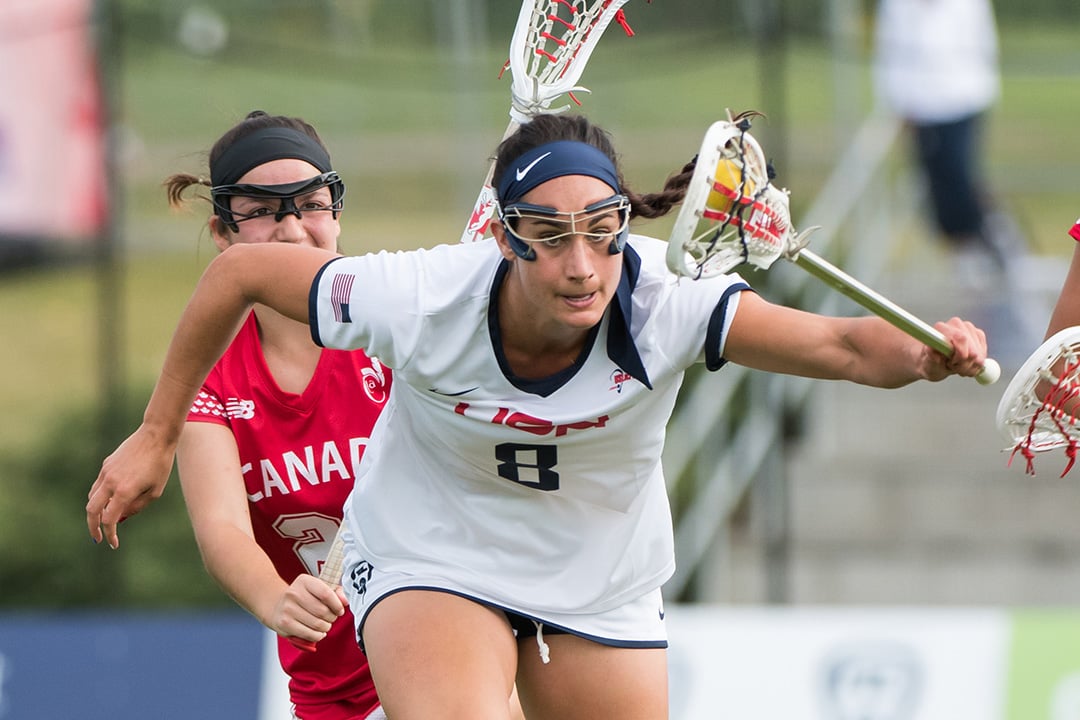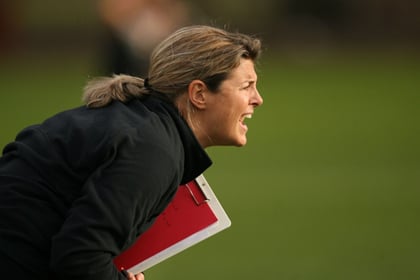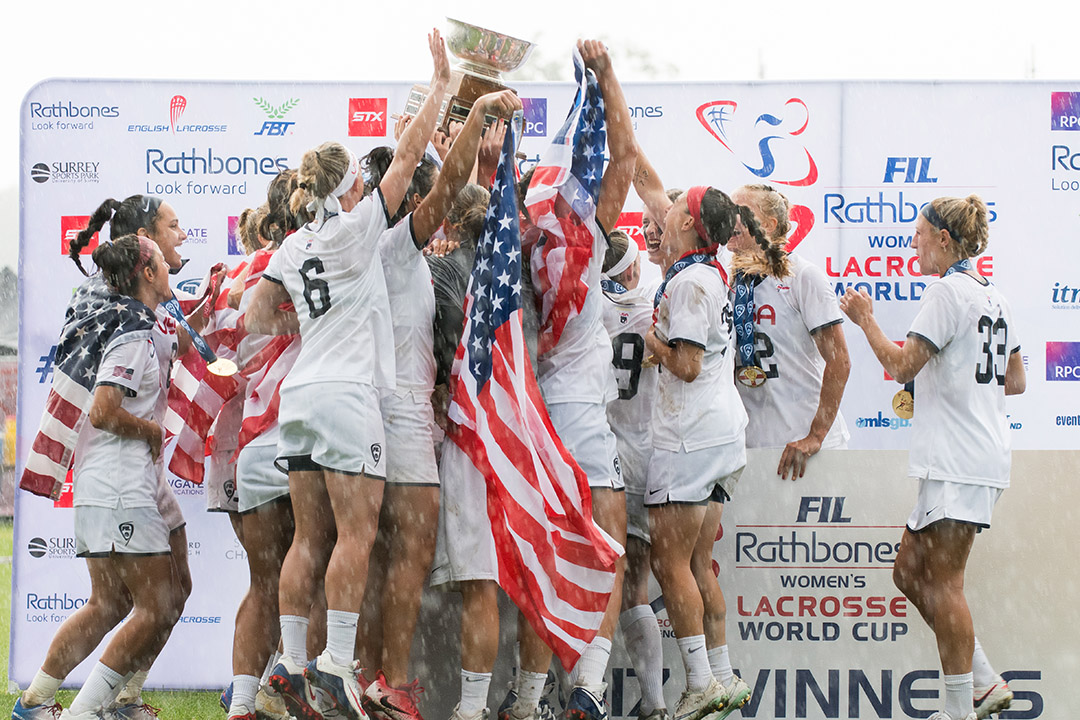The Perfect Storm
July 22, 2017 — It is a rainy Saturday afternoon at the Surrey Sports Park in Guildford, England. The buzzer sounds in the 2017 FIL Rathbones Women’s Lacrosse World Cup final. The U.S. team celebrates its 10-5 victory over Canada and its eighth gold medal with a dog pile.
“It had not rained almost the entire time leading up to the final game, and then it poured. It was the perfect storm,” commented Amy Bokker, Stanford women’s lacrosse head coach and the U.S. team assistant coach.
The U.S. had just won gold on the biggest stage of international lacrosse. In the slippery conditions, the U.S. offense was held to its second lowest output since 2009 but still clinched the title. With that victory, the U.S. improved to 60-6-1 in World Cup competition, proving its dominance in the world of lacrosse.
“We were playing for something bigger than ourselves. And there were so many emotions. Being able to hold up the trophy at the end — having achieved what you worked — for was indescribable. And better yet, to be able to do it with 17 other people is an incredible experience,” explains Stanford women’s lacrosse assistant coach and U.S. defender Kristen Carr.
Entering the final, the U.S. had competed in 10 days of pool play along with 25 nations. The U.S. averaged 18 goals per game before it met Canada in the gold medal game and had already defeated Canada 17-3 earlier in the tournament. The gold medal game was also a rematch of the 2013 World Cup final, where Carr and Bokker achieved their first U.S. gold medals.
After a few days of celebration the U.S. team traveled to Poland for the World Games, where the team made its debut on the world stage of the international multi-sport event organized by the International World Games Association.

Path to Olympic Recognition
July 30, 2017 — A Sunday afternoon in Wroclaw, Poland the U.S. team competes in The World Games final. They defeat Canada, this time 11-8. The crowd erupts as the U.S. team becomes the first ever women’s lacrosse two-time World Champion.
A week later, the U.S. was back at it again. This time they were among five other countries, including Poland, Canada, Australia, Great Britain and Japan, competing for the first time in the World Games, an event that is considered a springboard on the path to Olympic recognition for a sport. In this multi-sport tournament, teams attempt to vie for an Olympic bid as members of the Olympic committee evaluate the sport. Women’s lacrosse is not yet an Olympic sport, but many hope it will become one.
The U.S. national team ultimately trains to compete in World Cup play, but with the chance to showcase its sport internationally and compete for another medal, it seized the opportunity to participate in Poland.
One of the differences between the World Cup and the World Games besides the composition of the teams playing are the rule adjustments. Teams played with a 15-person roster rather than an 18-person roster and with 10 players on the field as opposed to the standard 12. The Federation of Lacrosse made these slight rule adjustments prior to the World Games in an attempt to appeal to the Olympic committee.
“With a smaller roster, it is easier for other countries to pick up teams. And with [fewer] people on the field, the game is easier to understand and more engaging,” explains Bokker.
Prior to the start of the World Games, there was an opening ceremony in which over 100 countries were honored for various sports. The crowd roared and fans stood up in awe when the U.S. lacrosse team was honored.
“The stadium erupted when we walked through and little kids were giving us high fives,” Karr describes. “I remember thinking how that was really what it is all about.”
“It was a moment I will never forget.”
Bokker and Carr Duo

[Earlier:] January 17, 2017 — A regular Tuesday afternoon practice at Stanford, only a few days out from the last three-day U.S. Women’s National Team tryout. Carr gets a call from the U.S. women’s lacrosse head coach, Ricky Fried. She is named to the 18-player World Cup roster. Carr’s Stanford team circles around her and jumps in excitement and awe.
The World Cup journey for Carr started in August of 2016 when she was selected out of 100 contenders to the 36-player roster of the preliminary U.S. training squad, which participated in the Team USA Spring Premiere. This Premiere, in which the U.S. played against top NCAA teams, Florida and Notre Dame, was the last showcase for the U.S. players before final cuts for the World Cup team were made.
Having been a member of U.S. team since 2008, Carr was no stranger to the intense U.S. selection process. Carr won her first goal medal in Canada at the 2013 World Cup, where she had a pair of goals and tied for the team lead with 10 groundballs. She graduated from North Carolina in 2010 and was named an IWLCA First Team All-American and first team All-ACC. Additionally, she held the single-season (64) and career (174) draw control records. With this tremendous lacrosse resume, the decision to put Carr back on the 2017 World Cup Roster seemed like a no-brainer.
“She is one of our most physical defenders,” Bokker concludes.
When asked what it meant for her to have been a part of the World Cup roster again, Carr responded, “I felt honored. There are many incredible players in our country, and to have been one of the final players selected to represent Team USA is a dream come true. That pride is felt every day and has inspired me to be the best version of myself.”
After selections in January the team only met once for training over Memorial Day weekend before the World Cup. Players were responsible to keep up their skills and fitness throughout the months leading up to England. Carr, who was in the midst of Stanford’s season, had to find the time in between coaching, film and traveling to put in that work. Coaching Stanford at this time allowed Carr to stay close to the game with a stick in her hand and made her eager for the summer ahead, when she could step onto the field in a different role. She found value in the transition between her roles on both teams because as a coach she was able to see the game from a different perspective and apply it to her own game.
“Being both a player and a coach, I can see both sides. I try to use that to my advantage and really put myself in the shoe’s of the players I coach at Stanford,” Carr adds.
Balancing her focus between team U.S. and Stanford, Carr was not alone. Stanford head coach and the U.S. team assistant coach, Amy Bokker was also coaching Stanford to a 12-6 season while preparing for a World Cup.
Bokker joined the U.S. Women’s Lacrosse National Team staff in 2009, around the same time she became the head coach at Stanford. Since then, she has helped the U.S. team capture three gold medals and has established the Cardinal as one of the west’s foremost programs with five MPSF titles and six NCAA tournament appearances. For Stanford, having two coaches as part of the U.S. lacrosse organization and as gold medal winners is a tremendous achievement for Stanford University Athletics. It is also an inspiration to its program’s players to play the game at the highest level.
“For me, I view [coaching the U.S. team] as the opportunity to have exposure to the game at that level,” Bokker concurs. “Also being able to coach both teams keeps me fresh and gives me the opportunity to work with high-level athletes, see what they are capable of and test them with new strategies and skill sets, which is then in turn pushing me to bring my best as a coach.”
“From that stand point, in relating the two teams, I would say that my goal is for my Stanford players to aspire to play at the level of the U.S. team. I have a good taste of what that is. And my players are also being coached and playing along side Kristen in practice, so they are able to see what it takes to play at that level.”
